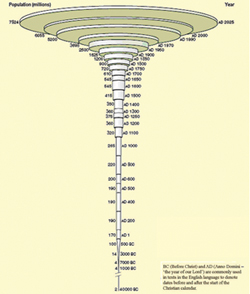Population size and growth
In the previous section you learnt about uncontrolled fertility and its impact on maternal and child health. Here we will look at the difference between population size and growth, and the link between fertility and population size and growth. It is important to differentiate between population size and the population growth rate. Population size is a measurement of existing population at any point in time, while the population growth rate tells us what is happening to the population in terms of whether it is growing, getting smaller, or remaining constant.
What will happen to population size if a country experiences a high birth rate with a corresponding high death rate?
This results in a slow increase in population size.
What will happen to population size if a country experiences a high birth rate with disproportionally low death rates?
High birth rates and disproportionally low death rates result in rapid population growth.
What will happen to population size if a country experiences both a low birth rate and a low death rate?
The population size will be well controlled and increase only slowly.
The main objective of family planning is to achieve this last scenario (a low birth rate, and a low death rate). Why? Because one of the factors that influences population growth is excess fertility. In countries where the fertility rate is higher than the death rate there will be fast population growth. This is typical of the current African population. Although the annual rate of increase varies from country to country, on average the world population is growing at 1.5% every year. If this growth rate continues (see Figure 1.1), the world population will be 12 billion by 2050. According to the 2007 Ethiopian census, this country's population is currently increasing by 2.6% (about two million) each year and should this rate of growth continue, it is estimated that the population of the country will double every 23 years.

As the population is growing very rapidly, the need for food, schools, jobs and health services is also increasing. Most of the countries in Africa already have high population growth rates estimated at 3% a year, and this is especially true of sub-Saharan Africa which includes Ethiopia. Therefore, it is becoming very difficult for these countries to provide enough food, schools, jobs and health services for everyone in the existing population.